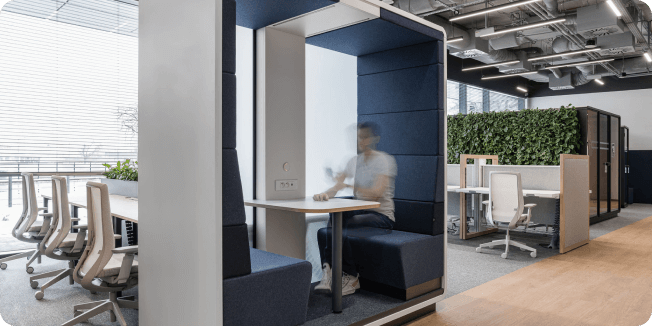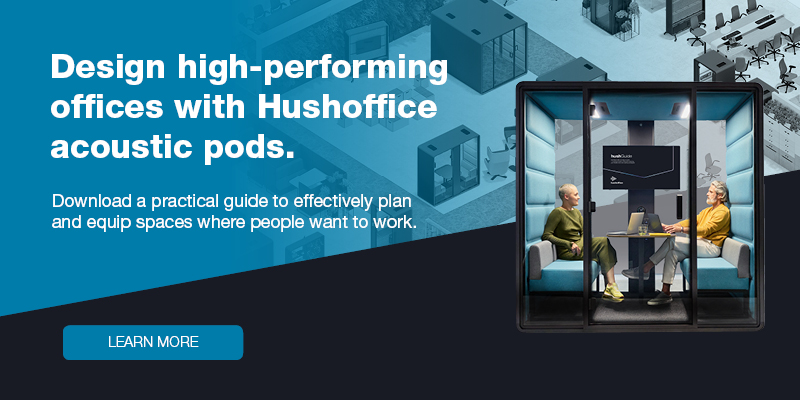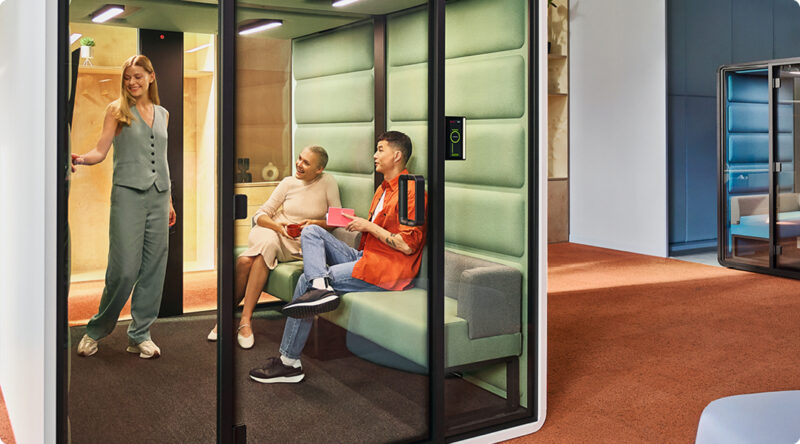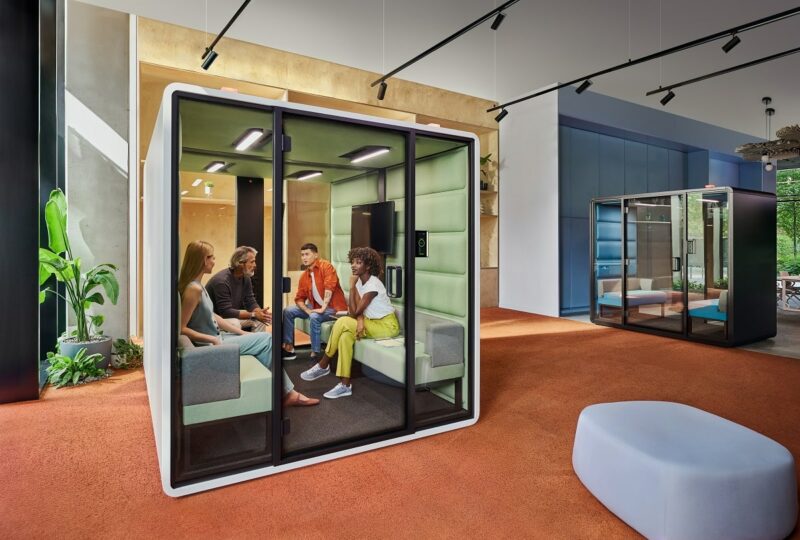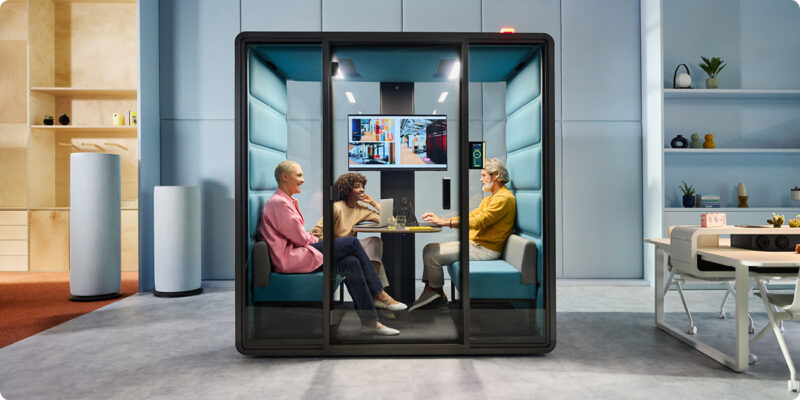Employee experience can be cleverly designed
- Posted on: 7 September 2023
- By: Hushoffice Team
What actually is employee experience? Why is it so important? What makes a positive one? Does the office play any role in it? The following article explains the key aspects of employee experience, highlighting the significant contribution that offices make to each employee’s path to improvement.
Employee experience – tl;dr
Employee experience involves all the connections, impressions, and emotions employees have from the moment they become part of your team. Key aspects of a positive employee experience are: competent leadership, sense of meaning, continuous learning, and a calm, productive working environment.
Employees with a positive experience show higher engagement. And actively involved employees mean a 41% decrease in absenteeism, a 17% rise in productivity, and 21% enhanced profitability. What’s more, engaged workers tend to have fewer health issues, such as pain, stress, and high blood pressure. Additionally, the probability of them recommending the employer to others is 23 times higher. So, generally, improving employee experience contributes to a more effective talent management strategy.
While the office is the key physical aspect of employee experience, optimising and improving it plays a significant role in enhancing the employee journey. In the hybrid reality, the office needs to smoothly support the social aspect of work. In addition, it should help maintain a healthy work-break cycle by providing employees with private spaces, such as Hushoffice pods, for regular breaks. It must also enable flawless video calls through the use of acoustic pods, such as hushHybrid.
In order to understand employee experience, you need to look at your company through employee eyes.
Employee experience can be defined as the total of workplace interactions, impressions, and emotions that workers have from the date they join your team. It refers to all the parts of their journey, such as physical workspace, company culture, and leadership styles.
Mapping an employee’s journey, starting from the day they are hired, helps visualise key touchpoints. It may be a highly effective technique to spot critical moments that considerably influence employees, whether positively or negatively. This process allows you to identify areas for improvement, which may require substantial changes. For instance, you can consider introducing meeting-free days for those who are overwhelmed with meetings, or investing in private call booths, such as hushPhone for workers who feel uncomfortable making personal calls in the open space
says Mateusz Barczyk, Senior Brand Manager, Hushoffice.
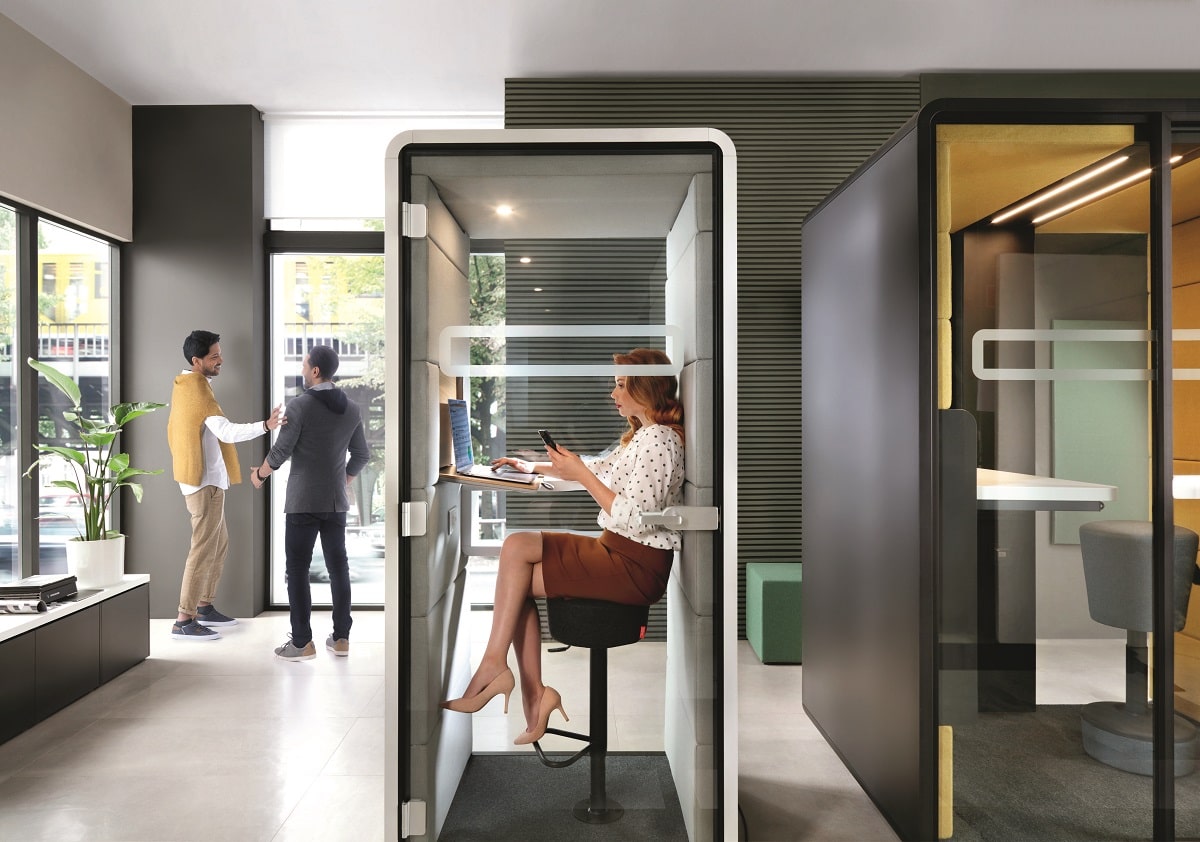
What key elements build a positive employee experience?
Strong leadership. Leaders are, in a sense, the conductors of a successful and balanced employee tune. Most of all, they should be open, approachable and empathetic. Good leaders communicate realistic expectations, provide assistance and coaching, and listen to employee problems attentively. They empower their team members and acknowledge their contributions, creating a safe psychological space necessary for others to take risks, share their ideas, and feel inspired at work.
Meaning. Human beings are meaning makers as meaning provides high motivation. That’s why tasks and duties should be assigned taking into account each employee’s individual values, interests, and abilities. Additionally, employees benefit from frequent reminders of how important their contribution is for the entire organisation. Another helpful tip is to appropriately challenge assignments and ensure autonomy in the decision-making processes.
Continuous learning. A sense of development and prosperity are key ingredients of a positive employee experience. It can be achieved by training programmes, mentoring, participation in workshops or conferences, and easy access to educational resources. No matter if delivered face-to-face in the office or via video conferencing in a pod, such as hushHybrid, a well-designed learning process makes working more effective and dynamic.
Calm, productive working environment. Comfortable and accessible workspaces are one of the key tangible aspects of employee experience. And, in this case, employees’ preferences are very clear: according to 87% of workers, the office should contribute to their well-being, with 89% supporting the idea of restorative areas in the office, such as Hushoffice pods for regular breaks. Apparently, workers know what they need, so consider surveying yours to pinpoint the areas with room for improvement.

Why is it important for your company to create a positive employee experience?
According to Gallup’s research, high engagement among employees contributes to a 41% decrease in absenteeism, a 17% rise in productivity, and 21% enhanced profitability. On the other hand, disengaged workers cost the organisation approximately 18% of their annual salary.
Engaged employees show more commitment to the big picture puzzle and higher motivation to improve their piece to solve it. They tend to stick to the plan, which contributes to higher efficiency, lower costs, and enhanced financial performance. Naturally, their attitude and engagement impacts customers as well – they give an extra effort to meet buyer expectations, fostering friendly problem-solving communication. This leads to a higher customer retention rate, which results in increased revenue. And it’s one of the many ways how enhancing employee experience can benefit your company
– says Mateusz Barczyk, Senior Brand Manager, Hushoffice.
Is there a relationship between employee experience and wellness?
They are closely connected. A pleasant experience can improve health, which, in turn, enhances the overall experience. In general, engaged workers tend to have fewer health problems, such as pain or stress. That’s why enhancing either aspect through, for example, promoting relaxation or using biophilic design (see: greenWalls), is beneficial for both health and experience.
The workplace design has an impact on employee psychology.
While open-plan offices foster connection and camaraderie, private workspaces improve focus, providing a self-contained space for hard-nosed problem solving. These two ends of the spectrum can be used to create an optimal, dynamic workspace where every task has its place.
New functions of the office: fostering connection, culture, and relationships.
The office serves many important functions in today’s hybrid working world. It is perfect for employees who find working from home less productive or inconvenient. It helps maintain a healthy work-life balance by drawing a line between working hours and personal time. It’s a shelter offering a variety of acoustically designed spaces for different kinds of tasks. And above all, it’s a meeting hub that fosters socialisation and promotes company culture. Read more: What is the office’s role in a hybrid work world?
On the whole, what workers missed most about the office during the isolation time were the human relationships it fosters. Just as variety is the spice of life, our everyday interactions, such as chance encounters in a conference room, or impromptu discussions in an office booth, like hushMeet.open, contribute to a more energetic and stimulating workflow
– adds Mateusz Barczyk, Senior Brand Manager, Hushoffice.
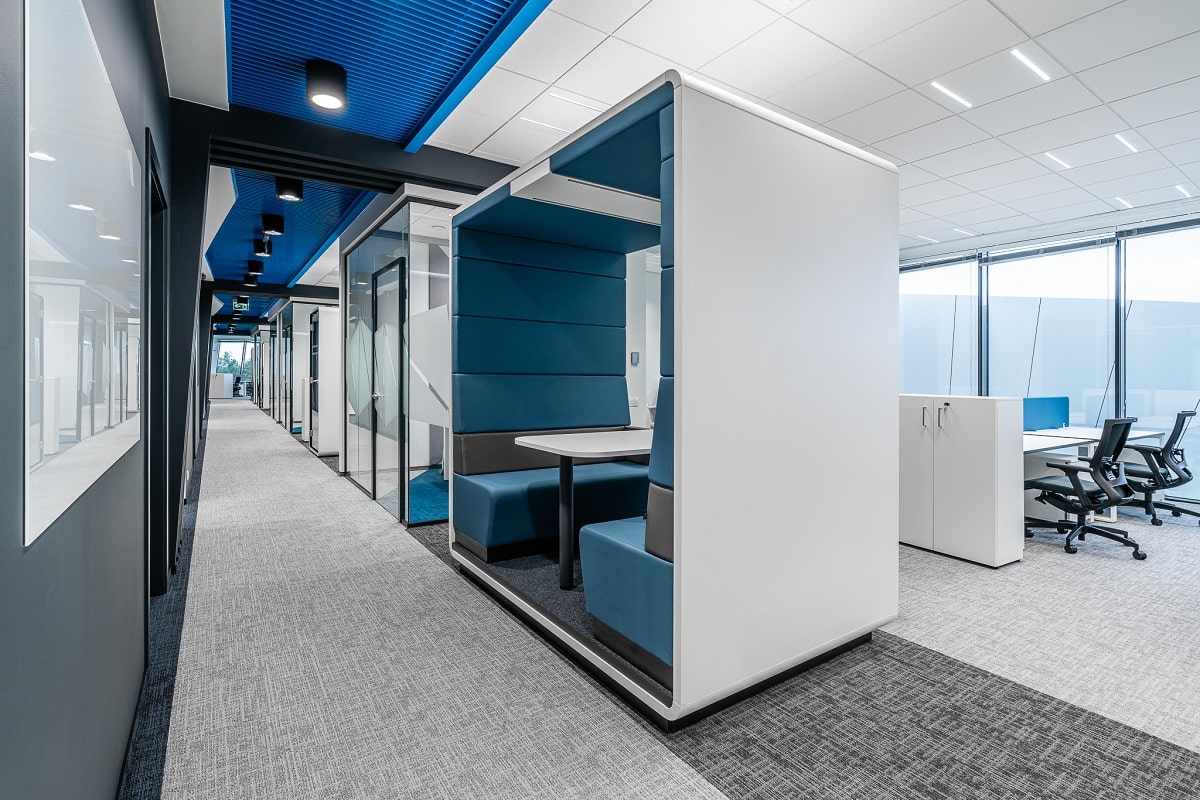
The contemporary office must encourage spontaneous collaboration and interaction, in other words, human involvement.
Employees with an office best friend tend to work more effectively and provide better customer service. In fact, these valuable bonds often start in the office where clients warm up, and investors connect with and decide to support your cause. The office is undoubtedly the heart of a hybrid team.
An innovative office design should influence employee psychology for good.
Effective workspace design leverages the complexities of human psychology to provide an inspiring and highly productive space that boosts employee well-being. Done well, it contributes to a flourishing and rewarding working environment for everyone.
Clever office zoning stimulates employee creativity.
Employees can make the best use of their office when it is divided into carefully-designed zones. For every task, workers may choose the zone with the working environment meeting their needs. When allowed to follow their creative flow, employees tend to work more effectively in a harmonious and balanced way.
Places to exchange ideas and collaborate.
Collaborative spaces fitted with whiteboards and other collaborative tools are ideal for informal brainstorming sessions. Private 4-person work pods, such as hushMeet, are perfect for confidential creative processes. The point is to offer a wide range of meeting spaces for employees to choose from.
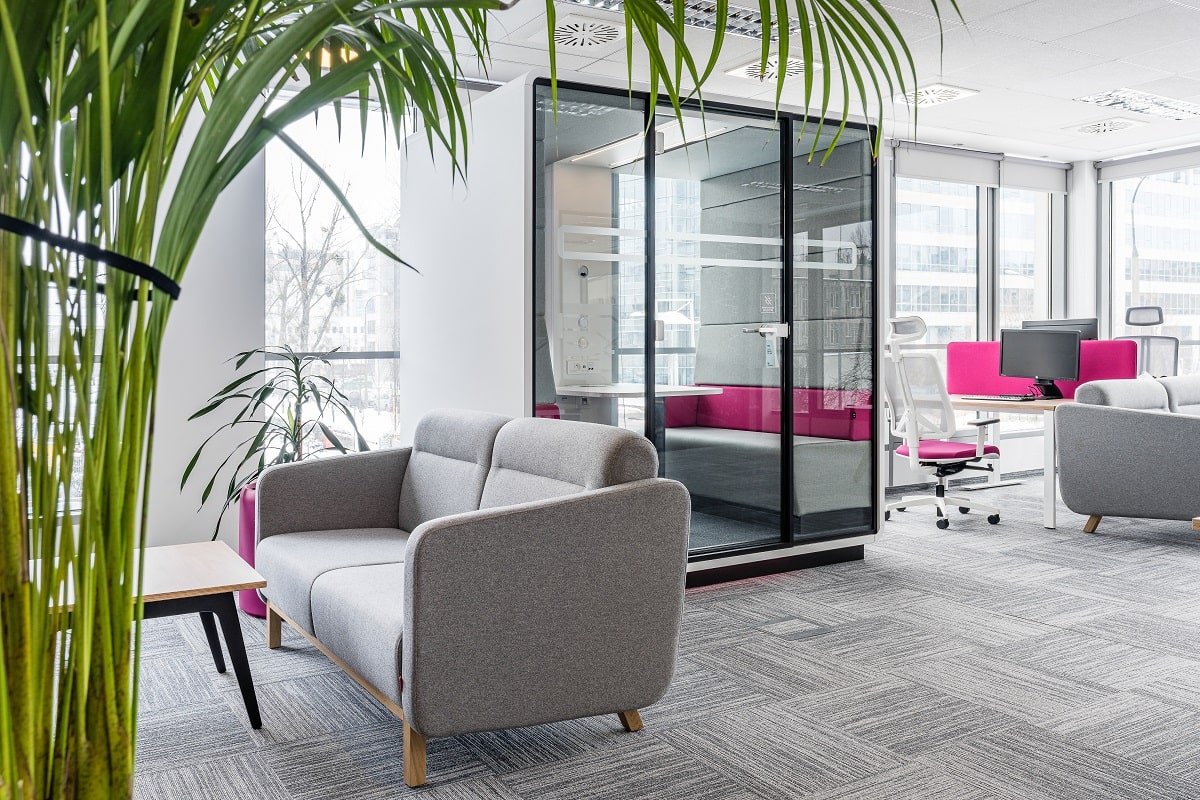
Relaxation zones are a must.
In today’s working world, burnout is a common problem, and relaxation is a big missing piece for many people. In fact, the more overworked a person is, the more they benefit from a regular rest. Pods, such as hushMeet.L make top-notch break rooms as they are private, calm, and furnishable for extra comfort.
Heads-down zones must be quiet and focused.
Office noise is one of the most common productivity killers in the workspace. It hinders cognition, focus, and our ability to think deeply. The easy solution is to provide self-contained, acoustic workspaces, such as the hushWork pod, which block out office noise and help foster focus.
And it’s not only creativity – noise affects all kinds of mental work. Read more: Noise, the silent productivity killer in the workplace.
An employee’s experience begins with their first interview.
The way prospective employees are treated throughout the interview, the responsiveness of the hiring process, and open communication are all key ingredients of a candidate’s impression of your organisation. A positive candidate experience also means word-of-mouth recommendations, which boosts your reputation.
Employee experience is an element of your long-term talent management plan.
Engaged companies have 59% lower employee turnover. And, if employees are engaged, the probability of them recommending the employer to others is 23 times higher. Satisfied employees are more likely to recommend top candidates. Moreover, when your organisation is known for a positive employee experience, you can attract the best of the best. What is your company’s employee journey like? Is it rather bumpy or smooth? Can you map it out to pinpoint areas for improvement? If you require more information about our Hushoffice pods, contact us here.
Employee experience design – summary
Employee experience involves all the connections, impressions, and emotions employees have from the moment they become part of your team. Key aspects of a positive employee experience are: competent leadership, sense of meaning, continuous learning, and a calm, productive working environment.
Employees with a positive experience show higher engagement. And actively involved employees mean a 41% decrease in absenteeism, a 17% rise in productivity, and 21% enhanced profitability. What’s more, engaged workers tend to have fewer health issues, such as pain, stress, and high blood pressure. Additionally, the probability of them recommending the employer to others is 23 times higher. So, generally, improving employee experience contributes to a more effective talent management strategy.
While the office is the key physical aspect of employee experience, optimising and improving it plays a significant role in enhancing the employee journey. In the hybrid reality, the office needs to smoothly support the social aspect of work. In addition, it should help maintain a healthy work-break cycle by providing employees with private spaces, such as Hushoffice pods, for regular breaks. It must also enable flawless video calls through the use of acoustic pods, such as hushHybrid.
Designing employee experience – frequently asked questions
What is employee experience?
Employee experience can be defined as the whole journey and interactions that employees have within a company, starting with the initial recruitment and onboarding process through continuous involvement and development up to potential offboarding. It is not only about job satisfaction, but also encompasses other aspects, like the working environment, workplace relationships, development opportunities, and wellness.
How can an office contribute to a positive employee experience?
The office should be zoned into areas that suit different work activities and patterns. It should include collaborative spaces, restorative zones, and focused areas, such as Hushoffice pods. The aim is to provide workers with a maximum variety of options to work and relax. Then your employees can instinctively recognise their needs, and make more efficient use of their workspace.
How does employee experience influence recruitment?
If employees are engaged, the probability of them recommending the employer to others is 23 times higher. Employers with a better employee experience enjoy higher reputation, so they are more attractive to top professionals.
